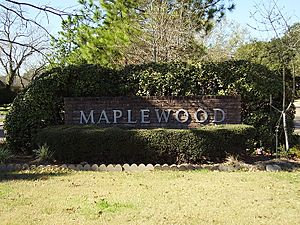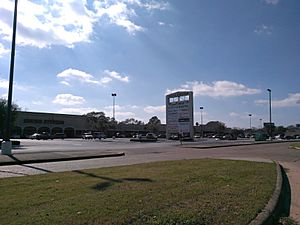Maplewood, Houston facts for kids
Maplewood is a friendly community in Houston, Texas. It's located just outside the 610 Loop, which is a big highway that circles parts of Houston, and is southwest of Downtown Houston. Maplewood has 524 homes, which are either one or two stories tall. The first houses in Maplewood were built in the early 1950s. You can find Maplewood near the streets Beechnut, Hillcroft, and Renwick.
The Maplewood Civic Club (MCC) is a group that helps look after the community and its residents. Maplewood is also part of Texas's 7th congressional district, which is an area represented by a member of the U.S. Congress.
Contents
A Look Back: Maplewood's History
In 1988, the Metropolitan Transit Authority of Harris County (METRO) suggested making Beechnut Street wider. People living in Maplewood, along with those from nearby Meyerland and Robindell, spoke up against these plans. They told the METRO board that a wider street would bring too much traffic. Because of their concerns, METRO decided not to go ahead with the widening project.
Later, in April 2010, the City of Houston started a new "automated" recycling program. This program made it easier for residents to recycle, and it was brought to the Maplewood community.
Shopping and Services in Maplewood
Maplewood Mall is a shopping center that serves the people living in the neighborhood. It's an outdoor mall that covers about 94,910 square feet. When it first opened in 1965, it was an indoor shopping mall.
In 2004, a company called New Plan Excel Realty updated the mall. They changed it from an indoor mall to an outdoor shopping center. A big celebration was held on August 6, 2004, to mark its grand re-opening. About 200 people attended, including a local TV personality named Marvin Zindler. All the stores that were there before the renovation stayed in the newly updated mall.
Learning in Maplewood: Schools and Education
Students in Maplewood attend schools that are part of the Houston ISD (Houston Independent School District).
Elementary Schools for Maplewood Students
Maplewood is divided into different zones for elementary schools. This means students go to the school assigned to their specific area. The elementary schools serving Maplewood are:
- Braeburn Elementary School
- Herod Elementary School
- Lovett Elementary School
- Sutton Elementary School
Middle Schools Serving Maplewood
After elementary school, students from Maplewood go to one of these middle schools:
- Fondren Middle School
- Long Middle School
- Pershing Middle School
If a student's home is zoned for Long or Pershing Middle School, they might also be able to apply to the regular program at Pin Oak Middle School.
High Schools for Maplewood Teens
Most of Maplewood, especially the areas east of Hillcroft, is zoned to Bellaire High School. However, some parts of Maplewood that are west of Hillcroft go to Sharpstown High School.
It's important to know that some areas people might think of as "Maplewood" (like Maplewood South) are actually separate subdivisions. Students from these areas attend Westbury High School.
A Look at Braeburn Elementary's History
Before the 1980s, Braeburn Elementary School mostly had middle-class, White students. After an economic downturn in the 1980s, many families from Central America moved into apartment buildings in the northern part of Braeburn's school zone. By 1990, only 5% of Braeburn's 1,000 students were White.
In 1992, some parents in the southern part of Braeburn's zone asked for their neighborhood to be moved to Herod Elementary. Herod was a high-performing school with mostly White students. However, the local school board member, Donald R. McAdams, did not agree to this request. He explained that moving this neighborhood would suggest that middle-class White children shouldn't go to a school with many poor Hispanic children, even if the school was very close by. Also, Herod Elementary was already very crowded at that time.
Nearby Catholic Schools
For families interested in Catholic education, St. Vincent de Paul Catholic School is a nearby option. It serves students from kindergarten through 8th grade and is part of the Roman Catholic Archdiocese of Galveston-Houston.



